Trading Indices
with CFDs
Trading indices through CFDs continues to rise in popularity among traders. Indices are considered a safer way to participate in the stock market, rather than trading individual stocks. With index CFDs, traders can spread risk across an entire market or market segment. Poor performance of a single stock is compensated for by the better performance of other stocks in the index. This results in lower levels of volatility.
Indices also help traders gain exposure to a variety of companies operating across different sectors. Trading in index CFDs is possible for all major indices including the FTSE 100, S&P 500, Dow Jones Industrial Average, ASX 200, China A50 and German DAX. For example, when trading the FTSE 100 as a CFD, you enter into a contract to exchange the difference in the price of the index from the time of opening the position to the time the position is closed.
With CFDs, you can open a position with a fraction of the capital required, since you do not need to actually own any stake or shares. However, before you start on your trading journey, here’s what you should know about indices, how CFDs work and what indices CFDs have to offer.


What are Indices?
Indices are a measure of the price performance of a section of shares or all the shares listed on an exchange. The selected shares could belong to a particular industry or from different industries. For example, the S&P/ASX 200 index is a market capitalisation weighted and float-adjusted stock market index of stocks listed on the Australian Securities Exchange. It includes the biggest individual companies such as BHP Group and Rio Tinto.
The constituents of this exchange are ranked relative to their market value, which is calculated by multiplying the market price with the total number of tradable shares. Investing in this index allows a trader to gain exposure to stocks with the highest capitalisation on the Standard & Poor's Australian Securities Exchange.
Similarly, the Financial Times Stock Exchange 100 Index (FTSE 100 or Footsie) is a share index of 100 companies with the highest market capitalisation listed on the London Stock Exchange. This index is considered to be a gauge of the prosperity of businesses in the UK. The Wall Street equivalent in the United States is the Dow Jones.

How are Indices
Calculated?
Stock indices can be calculated in several ways, with some giving greater weight to companies based on capitalisation while others list companies on the basis of stock price. Some popular methods of calculating the value of an index are:
The Market Capitalisation Weighted Method: Here, the stocks listed on the index are weighted using the market capitalisation of each company. The S&P 500 and ASX 200 are perfect examples of this type of index. Companies with the largest capitalisation will be responsible for the highest change in the value of the index.
The Price Weighted Method: Here, the stocks on the index are weighted by their share price. This means that companies with higher share price, regardless of their market capitalisation, will have a bigger impact on the value of the overall index. Examples of such an index are The Dow Jones Industrial Average or DJIA.
The Equal Weighted Method: Here, equal weightage is given to all the stock by calculating the returns on each stock, adding the returns of all the stocks and then dividing the total by the total number of stocks on the index.
What
Leads to Index
Price Movement?
The movement of a stock index depends on several factors, such as:
1.
Movement in its Constituents: Since an index is made up of several stocks, any change in their individual share prices is the biggest reason for a change in the value of the index.
2.
Economic News and Data: Major economic news, such as central bank announcements, industry specific reports, reports on inflation, unemployment, and policy changes can affect the stock markets and the underlying exchanges.
3.
Political News: Indices tend to move in response to trade-related decisions by the domestic government. Changes in regulations governing trade between two nations or local law reform can impact price movements.
4.
Change in an Index’s Composition: Addition or removal of stocks from an index can lead to a change in the value of the index.
5.
Commodity Prices: A change in the prices of commodities can lead to movements in industry-specific stocks and, therefore, indices with a high proportion of such stocks.
6.
Corporate Changes: Changes in the ownership or management of a company can lead to share price fluctuations and, therefore, the index on which it is listed.
Why Trade
Indices CFDs?
Indices are used by traders and economists to compare returns on different assets, to track the overall economy or as an investment vehicle. Indices can be global, regional or national.
Global indices comprise of equities from all across the world. The MSCI World Index, for instance, includes large- and mid-cap equities from 23 countries.
Regional indices comprise of equities from a particular region. For example, The S&P Asia 50 Index consists of the top 50 stocks in Asia.
National indices, as the name suggests, track the movement of the stocks of a particular country. Germany’s DAX 30 and Australia’s ASX 200 are examples of national indices.

A popular way to speculate on the price movement of indices is to trade them through CFDs. Ownership of the underlying asset is not required when trading CFDs and there is also the benefit of leveraged products. Reputable brokers offer index CFDs covering all the major indices which allow traders to gain global exposure. Those residing in Australia can access global financial markets through CFD markets which are available via advanced trading platforms.
The main reasons why traders prefer index CFDs are:
Trading opportunities: With CFDs, traders can open positions in both rising and falling markets. If the trader expects the value of an index to rise going forward, they could open a long position on the index through a CFD. Similarly, if they expect the value to decline in future, they can go short.
Hedging: Trading in index CFDs is an attractive way to hedge your positions in different shares. For example, if you open a short position on several individual stocks, you can hedge risks by entering into a long position on the index that includes the same stocks. Now, if the index rises in value, your index position will earn a profit and balance out the losses on your short stock positions.
Global Exposure: Trading in index CFDs allows traders to gain exposure to the global markets without having to invest in individual stocks. A trader in the EU could trade index CFDs of the US, Australia or Japan.
Leverage: As mentioned earlier one of the main attractions in CFD trading is leveraged products. This allows traders to enter positions of a much higher value than the funds available in their trading account. The amount that a trader needs to commit to the trade is called the margin. Profits and losses are calculated on the basis of your total position size and not the margin alone. This is where the high risk nature of CFDs becomes more apparent as both profits and losses are magnified..

What are the Benefits of
Trading in Index
CFDs?
Contracts for Difference or CFDs are contracts between two parties to exchange the difference in the price of an asset from the time the contract is opened to the date on which it closes. An index CFD allows investors to trade in the underlying index by speculating about its future price movement.

Exposure to a Wider Market: Trading index CFDs allows traders to gain exposure to an entire economic sector or an entire economy. This diversification entails lower risk than investing in individual stocks. Also, tracking the movements of several individual stocks can be difficult, while tracking the movement of an index is simpler.

No Ownership: Trading CFDs means that a trader can speculate on price movements without having to actually take ownership of the underlying asset. This reduces the overall cost of trading.

Less Volatile: The price movement of indices is smoother, since an individual stock cannot lead to a sharp change in the index value. This ensures that movements in indices are less volatile than those of individual stocks, yet sufficient to provide trading opportunities.


Easy Access to the Markets: Index CFDs allow easy access to newer markets, without having to worry about paying the clearing fees at the respective exchanges. So, traders can gain exposure to different economies across the globe at a lower cost than that for many other trading instruments.

Leveraged Trading: CFD trading involves leverage, which allows traders to open a larger position by investing only a small proportion of the total value.

Suitable for All Types of Traders: Index CFDs offer all types of traders the opportunity to take advantage of price movements. Indices reflect the broader economic scenario of a country or a region, therefore reducing the risk for traders with lower experience of the stock market. In addition, traders can choose their positions based on their risk appetite and trading horizon.
While there are multiple indices being traded across the globe, the most popular ones are:
FTSE All-World Index
S&P 500
DJIA
Nasdaq Composite
US30
US500
US Tech 100
DAX
S&P/ASX 200
FTSE 100
CAC40
Euro Stoxx 50
Nikkei 225

What are the
Different Types of
Indices CFDs?
Cash Index CFDs are a type of contract for difference that allows investors to track the movement of and trade the underlying index. The prices of these contracts may differ from the actual index levels as index CFDs are intended to reflect the best estimate of the cash price of the market at a future date. For this, the quotes are taken from the corresponding futures contract while adjusting for interest and dividend (fair-value adjustment).
Fair value is the theoretical calculation of the value of the futures contract, taking into account the current index value, any dividends that have been paid on the constituent stocks and the current interest rates. Some brokers conduct the dividend adjustments after the close of the business day, either as a cash adjustment into the trader’s trading account or included into the end of day swap rate.
CFDs are offered in two ways: one by a market maker and the other via Direct Market Access (DMA). Reputable brokers offer both options, while being transparent on the commission and spread levels.
Direct Market
Access
The direct market access model allows CFD traders to view and then interact with the live order books of global equity exchanges. Traders are an integral market participant when they opt for the DMA model. The order placed by a trader is passed directly to the underlying physical market, with no dealer intervention. This means real time execution and trading at real or live market prices.
In this model, the pricing is identical to the underlying market, making it a highly transparent system. Traders can see their orders being hedged in the underlying market, join a bid or offer queue and then participate in the opening and closing match out phases. This option allows traders to not only benefit from CFD trading but also all the benefits of trading shares.
When a trader opts for DMA, they can choose to hit the bid/offer or choose the buy/sell queue. This offers the opportunity to enter at a slightly lower price than via a broker. The speed and efficiency of the software platform being used will play a key role in the speed at which you can enter or exit a trade. Learn more about DMA CFD trading before you start.
Market Maker
Model for Stocks,
Indices,
Forex and
Commodities
This is the second option, where the market maker CFD provider gets an order from their client and then confirms the CFD trade with the trader. The market maker has a wide range of options to hedge the underlying position, such as by offsetting orders against other traders, buying shares, options, warrants or futures to ensure that it remains in a market neutral position.
A major difference in this model is that pricing approximates the underlying market. Some important points to remember are:
CFDs are not directly hedged in the underlying physical market. Instead, the market maker decides where to hedge a CFD position. So, the prices are not the same as in the underlying market.
Order execution is slower, since the decision to hedge CFD positions lies with the market maker.
The prices are controlled by the CFD provider.
Although the price and depth usually mirror the underlying market, this is not always guaranteed.
Some brokers offer both options for traders who wish to trade index CFDs. In the spread type contracts, the CFD provider acts as a market maker and sets the buy/sell prices above or below the current market price. The difference in the market price and the bid and sell prices is the spread. These brokers do not charge any commission for these trades and their service charges are covered in the spread itself.
What are the
Common Terms
Used
in Index CFD
Trading?
Before you start indices CFD trading, you need to be aware of the common terms associated with CFD trading:
Leveraged Trading: This process allows a trader to take a position that is larger than the funds available in their trading account. Leverage ratio is the amount of leverage provided by a broker, which can be as high as 500:1.
Initial Margin: This is the minimum amount that a trader needs to deposit in their trading account before initiating any position. For example, if the trader wishes to enter into a position worth A$250,000 and the leverage available is 20:1, the initial margin amount will be A$12,500 or 20% of the total amount.
Free Margin: This refers to the funds available in one’s trading account and currently not being used by open positions.
Balance or Free Equity: This is the sum of cash plus any net realised profits or losses on a trading account. This is calculated on the basis of one’s liquidated positions.
Margin Call: When the amount in the trading account falls below the minimum prescribed by the broker, the trader is notified to deposit the required amount in their trading account. This is called a margin call.
Bid and Ask Price: Bid price is the price at which the buyer is willing buy an asset, while the ask price is the price at which the seller is willing to sell the asset. So, if a trader enters into a long position, the order is executed at the ask price, while if the trader goes short, the price at which the order is executed is the bid price.
Spread: This is the difference between the ask and bid prices for a trading instrument and is the transaction cost to the trader. The bid price is usually higher than the current price of the instrument, while the ask price is usually lower than the current price.
Lot: It is the minimum position size of a trade.
Going Long: A long position refers to purchasing an index CFD with the expectation that the market value of the asset will rise in the near future.
Going Short: A short position refers to selling an index CFD, with the expectation that the market value will fall.
Stop Loss: A stop loss order is a risk management tool, used to protect the trader against large losses, in case the market moves in the opposite direction of their trade. This order calls for automatic closure of the open position, once the price drops to a predetermined level, set by the trader.
Take Profit: This is also a risk management tool that ensures the automatic closure of a position once the price of the asset rises to a pre-set profit goal. This tool is used to prevent the erosion of profits, if an unanticipated price reversal takes place before the trader closes their position.
Trailing Stop: This is a type of stop loss order that moves the stop loss level automatically as the price of the underlying asset fluctuates. For example, if a trader sets a trailing stop of 10 pips on a position, the position will remain open until the market price moves against the trader by 10 points. The position will be closed once the trailing stop is hit.
Pending Order: This order is set up with an instruction by the trader to open or close a position at a target price.
How to Start
Trading in Index
CFDs?
The first step is to open an account with a broker registered with the regulatory authorities, such as the CySec, ASIC or FCA. Regulated brokers work in accordance with the set rules and guidelines, in the best interest of the trader. This helps with a safe trading experience.
Some other factors need to be considered before finalising a broker, such as:
List of Index CFDs being offered for trade
The level of leverage offered
Spreads and commissions charged
Margin requirements
Type of customer support available
The trading platforms offered for trading. MetaTrader 4 and MetaTrader 5 are the most popular online platforms for trading CFDs.
Speed of order executions
Method of dividend adjustments
Payment options offered
Negative balance protection
Most CFD brokers offer beginners the option to open a demo account. It is so that those new to the concept can get a feel of trading the trading platform and develop trading strategies that best suit their financial situation. The demo account works in the same way as a live account, with the only difference being that real money is not at risk. There is no expiry date on demo accounts Once you are comfortable trading on the demo account, you can shift to a live account. When choosing a broker it is best to find one that is both licensed and regulated. In Australian, all renowned brokers have an Australian Financial Services Licence (AFSL). Be sure to read the product disclosure statement (PDS) and any associated risk warning.
Index CFDs are an attractive way of participating in the global stock markets. The global nature of forex means that trading hours are virtually 24 hours a day. They also allow you to hedge your investments in individual stocks or diversify your portfolio. Traders can choose to go long or short, depending on their perception of the future price movement of the chosen index. This allows traders to take advantage of both rising and falling markets.
 Access 10,000+ financial instruments
Access 10,000+ financial instruments Auto open & close positions
Auto open & close positions News & economic calendar
News & economic calendar Technical indicators & charts
Technical indicators & charts Many more tools included
Many more tools included
By supplying your email you agree to FP Markets privacy policy and receive future marketing materials from FP Markets. You can unsubscribe at any time.
Source - cache | Page ID - 20404